Is it poison ivy or .... ?
We'll attempt to answer your questions about if a particular plant is poison ivy (or one of the other toxic plants). Sometimes identification is difficult and may be just a best guess. If you've got additional questions or comments, be sure to contact us.
NOTE (May 15, 2003): Bear with me. I have about as many images to put up and discuss. This page is becoming too big for download and I'd like to put bigger pictures up. I'm reworking the page tonight and will get caught up with new submissions.
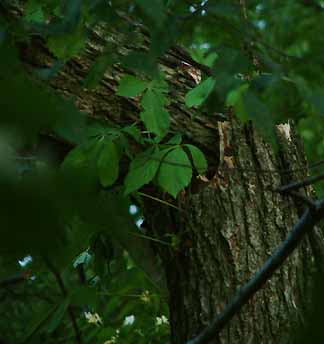 | Submitted by: Dan Trate
Date Submitted: May 12, 2003
Question Asked: This vine is common in a wood line on my property. Unfortunately a tree fell in a recent storm and it is covered with this plant. Due to the way the tree fell, I need to finish taking it down. Based on your site I'm identifying this as Virginia Creeper. Am I right or being overly precautious?
Answer: I don't think one can be too cautious. I do agree with you, Dan, that this is Virginia Creeper. I checked out both this picture and the other that you uploaded and don't see anything that would indicate otherwise. Be sure to check for any other vines around the base to make sure that there isn't a little hidden present waiting for you.
Comments welcome. |
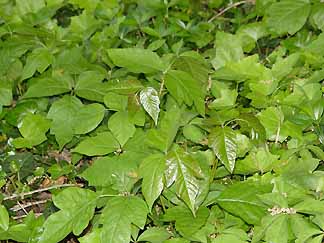 | Submitted by: Vernon
Date Submitted: May 12, 2003
Question Asked: None
Answer: Vernon didn't submit a question - I suspect he knows what it is he's taking a picture of. I wanted to post the picture here as its interesting to note that I saw at least 3 different vines in the picture. The poison ivy is the predominant plant in the picture (some of the leaves are shiny). In the middle back appears to be a vinca vine. And tucked in the right side looks like English ivy. Would be interesting to know what plant is the winner in the end.
Comments welcome. |
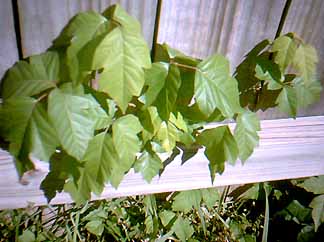 | Submitted by: Mindi
Date Submitted: May 12, 2003
Question Asked: We found this growing through our fence in East Tennessee, coming across from a field behind our house. We don't want this on our fence, but we need to know if it's poisonous. Answer: Mindi, thank you for a beautiful picture of poison ivy. Yes it's something you don't want on your fence and you should take care in removing it. Be sure to check the control section for suggestions from others on how to get rid of this noxious plant.
On a side note, it is interesting to see the variations in leaves as we're seeing in these submitted pictures. Just proves the point of Dr. William Epstein (noted expert) that poison ivy varies across the country.
Comments welcome. |
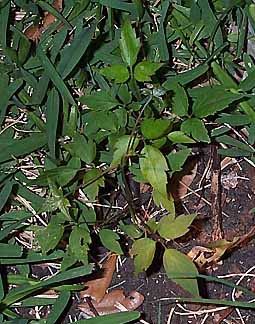 | Submitted by: Trish
Date Submitted: May 11, 2003
Question Asked: I planted a Clematis plant in this spot and I have a red rash after touching it today. The rash does not have blisters but I am concerned since I am expecting. Any information you can share is helpful. Answer: This looks like clematis to me. There are a number of species of clematis with a trifolate leaf including Clematis serratifolia. Could you have come in contact with poison ivy elsewhere? Or could it be that you are having an reaction to this plant? A number of plants in our gardens can be skin irritants to sensitive individuals.
Comments welcome. |
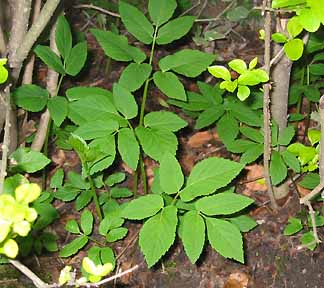 | Submitted by: Doug White
Date Submitted: May 11, 2003
Question Asked: Attached is a picture of a new plant growing under our Privet hedge. We first noticed it late last summer. Shortly after trimming the hedge my wife came down with a Poison Ivy rash. We were wondering if this could possibly be the culprit.
Answer: Doug, this is not poison ivy. Here are the characteristics of the plant that led me to this conclusion:
- The second set of leaflets (below the top/end set) are opposite.
- The second set of leaflets (below the top/end set) have only 2 leaflets (notice that one of the leaflets appears to be 2 combined).
- The stem is green and fleshy in appearance
I see that there are other plants in the background. Could there be something hiding in there? Could she be sensitive to other plants?
Comments welcome. |
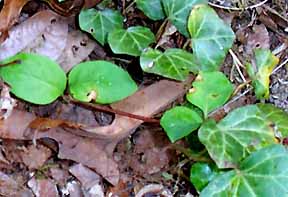 | Submitted by: Jeff Martin
Date Submitted: May 11, 2003
Question Asked: I know this is some kind of Ivy, I do not think its poison is it????
Answer: Jeff, neither of these 2 vines is poison ivy nor have urushiol oil. The one plant (with the white veins) looks like an English Ivy. This is an invasive plant and has some toxic properties which can cause dermatitis in sensitive individuals.
Comments welcome. |
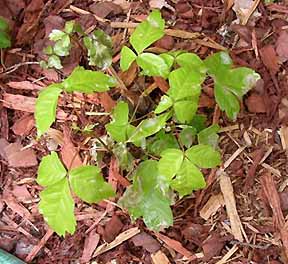 | Submitted by: Dina Lewis
Date Submitted: May 11, 2003
Question Asked: I came down with a terrible rash and allergic reaction two weeks ago and the doctor told me it was likely contact with Poison Ivy. Since I work in the yard a lot but am not sure about some of the plants we have, can you help me to identify if this is poison ivy??
Answer: This plant is your likely culprit for that rash, Dina. It looks like a nice little poison ivy plant. The leaves have the right shape and all but what's interesting is that the stem for the middle leaf is shorter than most I've seen. Can you tell me what region of the country you live in? I know that the plants can vary greatly in appearance across the country.
Comments welcome. |
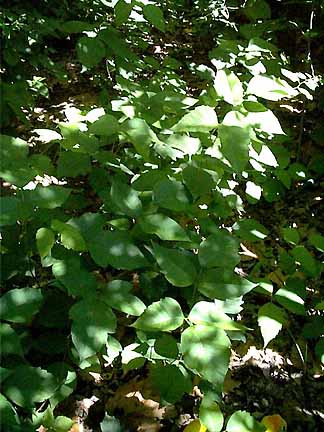 | Submitted by: Greg Crowe
Date Submitted: May 11, 2003
Question Asked: This ivy growth has taken over the side of my house. My neighbor has informed me that it is poison ivy. Can you verify? If you need any more pics, please let me know. The lighting made pics tough as my fence only let light in on certain patches.
Answer: Greg, it looks like your neighbor knows poison ivy. I'd have to agree that what we see here is indeed a nice little patch of poison ivy. Even though we can't see the vine or much of the stem, there are enough indicators here to say that it is poison ivy. Poison ivy grows especially well in disturbed ground, along the edges of woods, and similar areas. You should be able to get this under control with Roundup or similar if you don't want the plants so near the house.
Comments welcome. |
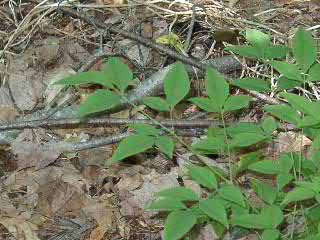 | Submitted by: Natasha
Date Submitted: May 8, 2003
Question Asked: Can you tell me if this is poison ivy? It is located right behind my 3 year olds swing set....how do I go about removing it permanently if it is?
Answer: Natasha, that plant isn't poison ivy. There are a number of vines and creepers which will invade opportunistically open spaces such as a child's play area. I blew up the picture to get a better view and saw that many of the leaf sets were comprised of 5 leaflets. Poison ivy has 3.
Comments welcome. |
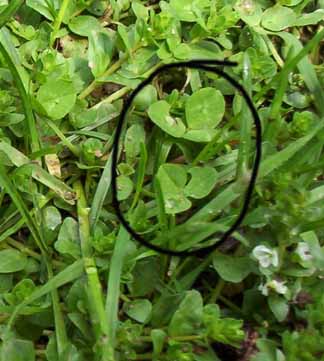 | Submitted by: Dan
Date Submitted: May 9, 2003
Question Asked: This is in the grass and is pretty small. Is this growing poison ivy?
Answer: Hi Dan. Thanks for the pictures and circling the detail as that helps when looking at a lot of green. This looks like clover to me. Poison ivy leaves vary greatly in size but the one true characteristic is the middle leaf is on a longer stem.
Comments welcome. |
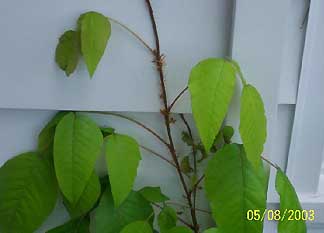 | Submitted by: Kory Labauve
Date Submitted: May 8, 2003
Question Asked: Is this poison ivy?
Answer: Don't you just hate it when poison ivy decides it likes your house as a place to grow? Yes that is poison ivy based on everything I see in the picture. A further out shot to give perspective would help but I don't think is needed here. The 3 leaves, the longer stem for the middle leaf, The general leaf shap, the "hairy" tendrils, coloration - all point to poison ivy. Interesting bit of trivia I've come across (and noticed in my quest to find poison ivy) is that what poison ivy looks like here in the Mid-Atlantic is not necessarily what it looks like in say Michigan. There are regional differences plus 9 different poison ivy species.
Comments welcome. |
 | Submitted by: Debbi
Date Submitted: May 7, 2003
Question Asked: I found several of these growing in my garden. They have a real long top that they wrap around my other flowers. What is it?
Answer: Hi Debbi. I haven't been ignoring your submission but I've been mildly stumped on this one. I do know it - I just can't remember where I've seen it before. My field guides have been useless on this one (time to go book shopping again). I do not believe this is poison ivy and here's why. Poison ivy vine is a generally clinger using tendrils not so much a twiner (as in this plant). Lack of tendrils along the vine (from what I could make of the picture). Even the leaf shape doesn't "feel right" but since that's not scientific don't put much weight in it. There are quite a few climbers with trifolate leaves (3 leaflet leaves) which are not poison ivy such as Hog Peanut which this plant does resemble. I'll do some more looking and dig deep to see if the name finally comes to me.
Oh and for future reference to others - please don't place what may be a poisonout plant on surfaces that you come in contact with often :-)
Comments welcome. |
 | Submitted by: Lucia Doughty
Date Submitted: May 8, 2003
Question Asked: Can you tell me what this plant is and if it is poisonous?
Answer: This plant I know well as it can be quite invasive here. This is Virginia Creeper. Key identifying characteristics include 5 leaflets on a palmated leaf, the characteristics of the tendrils, toothed leaves. You can find more information on here on Virginia Creeper
Virginia Creeper is not poisonous in the same sense as poison ivy or other members of the Toxicondendron family. It does though contain oxalate crystals and can be a skin irritant to some and is definitely an irritant if eaten. Many of the references I've come across do not list Virginia Creeper as a skin irritant (the California Poison Control System does though) so it probably is not a major irritant for most.
Comments welcome. |
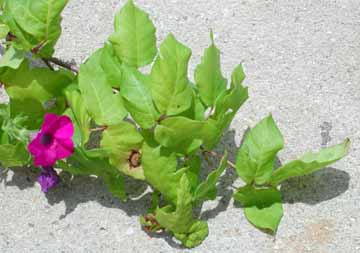 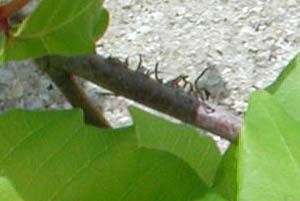
| Submitted by: Bob Waterhouse
Date Submitted: May 7, 2003
Question Asked: My wife loves ivy because it does not die back in the winter. She picked this sprig the other night, it was growing on a tree in a restraunt parking lot. Today I had to take her to the doctor, she started itching the next day but this morning she woke up with swollen eyes and blisters on her face. The flower was pulled up by mistake, is it posion ivy?
Answer: Thanks for the excellent picture, Bob. I'm afraid that what you've shown us here very much looks like poison ivy. Yeah - I'd say it is poison ivy. The vine shows the general characteristics of poison ivy with the 3 leaflet leaves with the middle leaflet being on a longer stem. The vine has "hairy" growth that I mention often (as seen in the second picture here - I cropped out the section so show better detail). The leaves are generally oblong in shape and pointed (I've seen variants but this is most common).
I'm sorry to hear about your wife's reaction to the plant. It's not fun having to deal with the rash especially in sensitive places like the face. Poison ivy is actually a pretty nice looking vine (so I understand the attraction) but has urushiol oil which makes it toxic to most folks.
Comments welcome. |
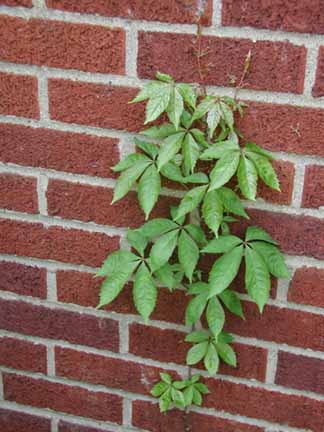 | Submitted by: Cindy Matchett
Date Submitted: May 5, 2003
Question Asked: I ran into this vine while weeding around my house. The worst effects on my body are my legs. I have included 1 picture of the vine and 2 pictures of it's affect on my legs after 1 week of treatment with an oral prednisone prescription. It was greatly improved when these pictures where taken.
Is it poison? It has more than 3 leaves.
Answer: Nice picture of the vine, Cindy. This is Virginia Creeper. Virginia Creeper is a vine and grows under similar conditions to poison ivy. The dead giveaway here are the 5 toothed, palmate leaves and the little tendrils on the vine which attach the vine to the brick. Virginia Creeper sap apparently contains oxalate crystals which can cause in some individuals contact dermatitis. Click here for more information on Virginia Creeper.
Comments welcome. |
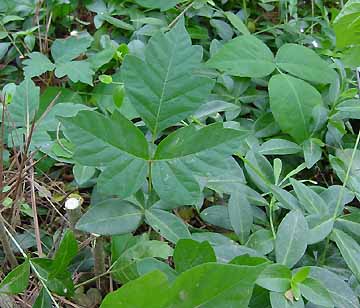 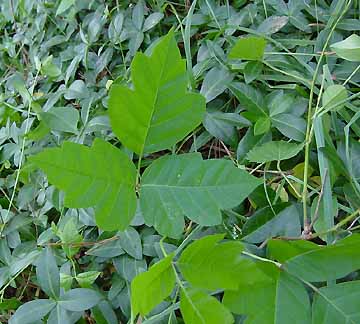
|
Submitted by: John Ortakales
Date Submitted: May 4, 2003
Question Asked: Is this poison ivy?
Answer: Well John, you've got me scratching my head. I've been over and over these 2 pictures (in the larger version you sent) and I can only see bits and pieces of the stem and possible vine. Also, the leaves just don't look right to me for poison ivy. I'm going to take a giant leap here and identify this as poison oak. In the top picture in the upper right corner is a 3 leaflet configuration which definitely resembles poison ivy to me. The big 3 leaflet set in the middle of the picture though has many lobes and doesn't resemble the poison ivy I've seen. I reviewed many pictures of poison oak and found this site which has pictures closely resembling what you've sent. What I don't know and what I should have asked was what region these pictures were taken in. I'm not terribly confident in the identification and I hope that others might be able to shed some light here.
Comments welcome. |
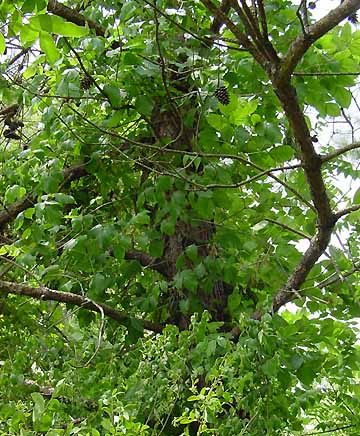
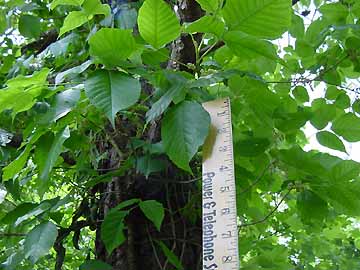
|
Submitted by: John Ortakales
Date Submitted: May 4, 2003
Question Asked: Is this poison Ivy? I'm assuming it is.
Answer: Thanks for some great pictures, John. You are correct - this is classic poison ivy. These poison ivy "trees" can fool many people especially when they take over a tree and create a new canopy. Notice the buds forming on the second picture. Those are some very long leaves though not unusual.
Comments welcome. |
 | Submitted by: Steven Chandler
Date Submitted: May 4, 2003
Question Asked: Is this poison Ivy?
Answer: Though I can't see the stem, I would say this is poison ivy. The leaves, the general look, all points to poison ivy. If I could see more of the stem I would be more sure. Poison Ivy is a woody plant and the vine itself tells much about the plant.
Comments welcome. |
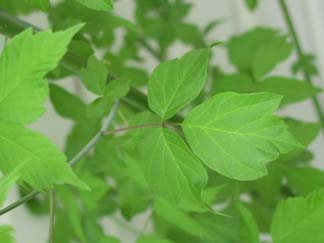 | Submitted by: Marcos
Date Submitted: May 3, 2003
Question Asked: I am not sure what this plant/tree is, but it does show that characteristics of Poison Ivy (except the leaves are not that shiny? What do you think.
Answer: Marcos, thanks for an excellent picture. This is not poison ivy, it is an Ashleaf Maple (aka Boxelder). You're right about the characteristics in the leaf but there are some key differences. I'm assuming this is a very young tree and in time you'll be able to see more of the differences. Notice that there are branches (blue-green in color) coming from a main stem (green in color). As the tree ages, you'll notice the lower portion of the trunk will become brownish in color and rougher. Also, some of the leaflet sets will have anywhere between 3 and 7 leaflets.
I'm working on a new section on this website about similar plants. Here's my info on the Ashleaf Maple.
Comments welcome.
|
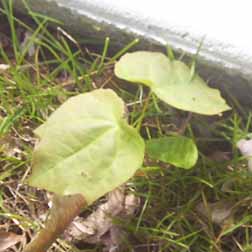 | Submitted by: Joe
Date Submitted: May 1, 2003
Question Asked: Is this poison ivy?
Answer: Hi Joe. From the
pictures you sent in (the other 2 were a bit fuzzy), this looks to be a
young tree. I'm not as strong in identifying young trees -
perhaps a maple or sycamore? I'll have to leave final identification to
another. Poison ivy leaf structure is trifoliate - meaning it has a a 3
part leaf with the middle leaf (or leaflet) on a longer stalk.
Comments welcome.
|
|

